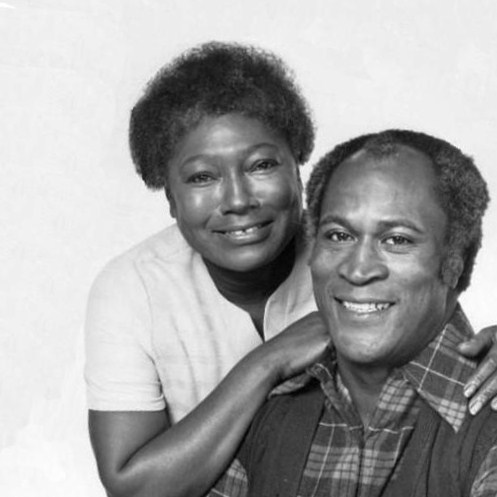
John Allen Amos Jr., a towering figure in American entertainment whose career spanned over five decades, recently passed away at the age of 84. His death on August 21, 2024, though not announced until October 1, marked the end of a remarkable life defined by resilience, talent, and an unwavering commitment to authentic storytelling. Amos was not merely an actor; he was a cultural touchstone, beloved by millions who knew him as the stern yet deeply loving patriarch James Evans Sr. on “Good Times,” or as the resilient adult Kunta Kinte in the groundbreaking miniseries “Roots.”
Born into an era of profound social change, Amos navigated a complex path, transitioning from aspiring athlete and social worker to a revered performer who broke barriers and challenged stereotypes on screen. His ability to imbue his characters with both strength and vulnerability resonated deeply with audiences, creating indelible portrayals that reflected the rich tapestry of the African American experience. This article delves into the many facets of John Amos’s extraordinary journey, celebrating the man who, as his son Kelly Christopher Amos eloquently stated, “was a man with the kindest heart and a heart of gold… and he was loved the world over.”
As we reflect on his passing, it becomes clear that John Amos’s impact extended far beyond the characters he brought to life. He was an advocate for positive representation, often pushing against creative decisions that he felt compromised the integrity of the Black narrative. His life story is a testament to perseverance, artistic integrity, and the power of a performer to leave an indelible mark on the cultural consciousness, earning him a place among the true legends of American media.

1. **A Life’s Journey Begins: Early Years and Education**John Allen Amos Jr. entered the world on December 27, 1939, in Newark, New Jersey, the son of auto mechanic John A. Amos Sr. and Annabelle Amos. His formative years in East Orange, New Jersey, cultivated a strong sense of identity, leading to his graduation from East Orange High School in 1958. His early education laid the groundwork for a life dedicated to understanding people and the arts.
His pursuit of higher education led him to Long Beach City College and later Colorado State University, where he earned a degree in sociology. During this time, he distinguished himself on both schools’ football teams, demonstrating a commitment to both academic and athletic endeavors. This background in sociology undoubtedly informed his nuanced portrayals of complex characters throughout his acting career, allowing him to bring a unique depth to his roles.
The blend of his New Jersey roots, robust educational background, and a burgeoning interest in sports and social studies provided a multifaceted beginning to John Amos’s remarkable life. These early experiences nurtured a thoughtful and disciplined individual, preparing him for the diverse challenges and opportunities that lay ahead in both his personal and professional spheres. His foundation was built on intellectual curiosity and a strong work ethic.
Read more about: Jessica Biel’s Journey: Unpacking the Gorgeous Transformation of an A-List Icon Through the Years

2. **Beyond the Gridiron: Football Dreams to Social Work Realities**Before he became a celebrated actor, John Amos pursued a professional football career, showcasing his dedication and physical prowess. In 1964, he signed a free agent contract with the Denver Broncos, but a pulled hamstring led to his swift release. Undeterred, he played for various teams in different leagues throughout the mid-1960s, maintaining his athletic ambition.
In 1967, he signed with the Kansas City Chiefs, where Coach Hank Stram candidly advised him, “You’re not a football player, you’re a man who is trying to play football.” This pivotal moment seemed to subtly guide him towards a different path. He then channeled his passion for understanding people into a career as a social worker in New York City.
This role as a social worker allowed him to directly engage with his community, utilizing his sociology degree and innate empathy. The experience gained from addressing human struggles profoundly enriched his acting performances, lending authenticity and humanity to the complex characters he would later bring to life on screen.

3. **The Dawn of an Acting Career: Early Appearances and Breakthrough**The transition from social work and sports to acting marked a new, vibrant chapter in John Amos’s life. His entry into entertainment began with early commercial work, notably appearing with Anson Williams in a 1971 McDonald’s commercial, which introduced him to a wider audience. In the same year, he secured a small part as a radio engineer in the cult film “Vanishing Point,” gaining valuable early experience in film production.
His true breakthrough on the small screen arrived with his first major television role as Gordy Howard, the weatherman on “The Mary Tyler Moore Show,” from 1970 until 1973. Amos became a familiar and welcome face, showcasing his comedic timing and ability to fit seamlessly into an ensemble cast. His consistent presence on such a popular program solidified his standing as a rising talent in the industry.
This foundational experience established him as a recognizable and respected actor, highlighting his ability to portray characters with warmth and intelligence. The impact of his role on “The Mary Tyler Moore Show” proved instrumental in his career trajectory, setting the stage for the iconic performances that would soon follow and cement his place in television history.

4. **Challenging the Sitcom Mold: James Evans Sr. on ‘Good Times’**John Amos’s portrayal of James Evans Sr. on the CBS sitcom “Good Times” remains one of his most iconic and defining roles, deeply embedding him in the fabric of American popular culture. From 1974 to 1976, Amos embodied the hardworking, principled husband of Florida Evans and father of three, a character that resonated profoundly with audiences grappling with the realities of urban life. His performance transcended typical sitcom tropes, bringing a grounded realism to the screen.
Before “Good Times” premiered, Amos had already introduced the character of Henry Evans, who would become James Evans Sr., in three prior appearances on the sitcom “Maude.” This prior development allowed him to fully inhabit the role when the spin-off series launched, portraying a character that was simultaneously strong, vulnerable, and deeply committed to his family’s welfare. The series aimed to depict a positive image of an African-American family facing adversity in a poor neighborhood, a vision that Amos wholeheartedly supported.
What makes Amos’s performance particularly remarkable is the stark contrast between his actual age and the character he played. At 34 when production began in January 1974, he was only eight years older than Jimmie Walker, who played his oldest son, and 19 years younger than Esther Rolle, his on-screen wife. Despite this age disparity, Amos convincingly conveyed the gravitas and wisdom of a middle-aged patriarch, a testament to his acting skill and commanding presence.
However, the role of James Evans Sr. was not without its complexities and challenges for Amos. He openly expressed dissatisfaction with the show’s creative direction, particularly as he felt the premise of portraying an authentic African-American family struggling against odds was being “slighted by a lower level of comedy.” His dedication to accuracy and meaningful representation would lead to significant friction behind the scenes, shaping both his tenure on the show and its eventual narrative arc.

5. **An Icon’s Battle: Creative Conflicts and Dismissal from ‘Good Times’**John Amos’s tenure on “Good Times,” while iconic, was also marked by significant creative clashes that ultimately led to his premature departure from the show. His commitment to authentic representation of the African-American experience drove him to challenge the show’s writers and producers, particularly regarding what he perceived as a dilution of the series’ initial promise. These disagreements highlighted his integrity as an artist and advocate.
A central point of contention for Amos was what he felt was an undue emphasis on Jimmie Walker’s character, J.J., and a corresponding “lesser regard for the other two Evans children.” He was critical of J.J.’s “stereotypical buffoonish personality,” believing it undermined the show’s potential to present a nuanced and dignified portrayal of a Black family. In a 2017 interview, Amos frankly stated that the sitcom’s writers “did not understand African Americans.”
He famously confronted the writers, asserting, “That just doesn’t happen in the community. We don’t think that way. We don’t act that way. We don’t let our children do that.” These passionate arguments underscore his unwavering dedication to verisimilitude and his desire for the show to reflect a more accurate and positive image. Amos sought to elevate the narrative beyond broad comedic strokes, aiming for a depth that he felt was being sacrificed for cheap laughs.
These open clashes with the show’s writers and executive producer Norman Lear ultimately culminated in his dismissal at the end of season 3 in 1976. The writers subsequently killed off his character, leading to one of television’s most memorable and poignant scenes, where his screen wife, Esther Rolle, screamed, “Damn! Damn! Damn!” His abrupt exit, though controversial, cemented his stance as an actor who prioritized artistic integrity and social responsibility over commercial longevity.
.jpg/440px-Roots_The_Saga_of_an_American_Family_(1976_1st_ed_dust_jacket_cover).jpg)
6. **The Enduring Power of ‘Roots’: Portraying Kunta Kinte**Following his departure from “Good Times,” John Amos swiftly transitioned into another profoundly significant role: the adult Kunta Kinte in the landmark 1977 ABC-TV Miniseries “Roots.” This critically acclaimed adaptation of Alex Haley’s seminal book became a cultural phenomenon, captivating the nation and profoundly altering perceptions of American history and slavery. Amos’s powerful performance was central to its impact.
Amos portrayed the resilient Kunta Kinte, an African man captured and enslaved, depicting his struggle for freedom and dignity across generations. His portrayal was both physically demanding and emotionally harrowing, requiring a profound immersion into the character’s suffering and unwavering spirit. This role allowed him to showcase his dramatic depth and his ability to convey immense emotional gravity, far beyond the confines of a sitcom, earning him critical acclaim and a Primetime Emmy Award nomination.
“Roots” transcended mere entertainment, becoming a vital educational tool and a source of inspiration. For Amos, it provided an opportunity to contribute to a project of immense social and historical importance, further aligning his career with his personal commitment to authentic and meaningful African American representation. His portrayal of Kunta Kinte remains an indelible part of television history, a testament to his ability to bring complex human stories to life.
7. **From Screen to Stage: Versatility in Theater and Notable Film Roles**Beyond his groundbreaking television work, John Amos demonstrated remarkable versatility across both the big screen and the theatrical stage. He ventured into playwriting and producing with “Halley’s Comet,” a critically acclaimed one-man play performed around the world, showcasing his capabilities as a storyteller and creator. His dedication to theater also led him to Broadway, where he performed in August Wilson’s “Gem of the Ocean,” later reprising the role at the McCarter Theatre.
His film career also began to flourish, offering him roles that spanned various genres. One of his first starring film roles was in Disney’s “The World’s Greatest Athlete” in 1973, appearing with Tim Conway and Jan-Michael Vincent. This comedic role demonstrated his lighter side, providing a contrast to more dramatic portrayals.
Amos continued to build a substantial filmography, co-starring with Bill Cosby and Sidney Poitier in “Let’s Do It Again” (1975). His early film appearances also included “Vanishing Point” (1971) and “The President’s Plane Is Missing” (1973). These varied roles underscored his growing reputation as a reliable and compelling actor capable of handling diverse cinematic projects, marking him as a significant presence in American film.
Read more about: Alan Arkin, Oscar Winner and Versatile Force, Dies at 89: A Legacy of Wit, Depth, and Unforgettable Performances
8. **Expanding the Television Landscape: Post-‘Roots’ and Recurring Roles**Following the indelible impact of “Roots,” John Amos continued to be a dynamic presence on the small screen, refusing to be pigeonholed by his most iconic roles. His career trajectory in television demonstrated a profound adaptability, as he moved effortlessly between dramatic miniseries, ensemble comedies, and intense police dramas, showcasing a range that solidified his reputation as a respected and versatile actor in the industry. Early in this phase, he starred in the 1980 television film “Alcatraz: The Whole Shocking Story,” delivering a performance that further cemented his dramatic capabilities.
Amos became a familiar and authoritative figure in several significant recurring roles that resonated with audiences. He notably graced “The West Wing” for 22 episodes as Admiral Percy Fitzwallace, the Chairman of the Joint Chiefs of Staff, a role that brought a quiet gravitas and wisdom to the political drama. Similarly, his portrayal of Buzz Washington in the ABC series “Men in Trees” across 27 episodes offered a more character-driven performance, illustrating his capacity to inhabit diverse narrative landscapes and contribute significantly to ensemble casts.
His comedic timing and ability to blend into various narrative styles were further showcased through his work in sitcoms. Though short-lived, his role as Ernie Cumberbatch in the 1994 spin-off “704 Hauser” offered a different take on the family patriarch, and he co-starred with Anthony Anderson in “All About the Andersons” from 2003 to 2004, appearing in 16 episodes. Later in his career, he delighted audiences with recurring guest roles as characters named Ed on both “Two and a Half Men” and Netflix’s “The Ranch,” demonstrating his enduring appeal and comedic warmth.
Beyond these extended engagements, Amos maintained a prolific career as a guest star across a spectrum of popular television programs. His appearances on shows such as “Police Story,” “The A-Team,” “The Cosby Show,” “The Fresh Prince of Bel-Air,” “In the House,” “Martin,” “Touched by an Angel,” “Psych,” “Sanford and Son,” “My Name Is Earl,” “Lie to Me,” and “Murder, She Wrote” underscore his consistent demand and the breadth of his influence across multiple decades of American television. Each role, no matter how brief, bore his distinctive mark of authenticity.

9. **A Rich Cinematic Tapestry: Diverse Filmography**John Amos’s contributions to film paralleled his extensive television career, revealing a rich and varied cinematic tapestry that spanned genres and showcased his enduring presence on the big screen. Beyond his earlier notable features, he continued to embrace roles in a wide array of productions, from fantasy epics to character-driven dramas. Films like “Touched by Love” (1980), “The Beastmaster” (1982), “Dance of the Dwarfs” (1983), and “American Flyers” (1985) highlighted his versatility in different storytelling contexts.
Among his most recognizable big-screen performances was his role as Cleo McDowell, the proprietor of McDowell’s, in the critically acclaimed 1988 comedy “Coming to America.” This character, with his humorous rivalry to McDonald’s, became an indelible part of pop culture and a fan favorite. Amos reprised this cherished role decades later in the 2021 sequel, “Coming 2 America,” a testament to the character’s lasting appeal and his own enduring talent.
Amos also demonstrated his capacity for more intense, action-oriented roles. His portrayal of Captain Meissner in the 1989 Sylvester Stallone vehicle “Lock Up” and as Major Grant in the blockbuster sequel “Die Hard 2” (1990) showcased his ability to command the screen in high-stakes thrillers. These performances added another dimension to his acting portfolio, proving he was equally adept at serious dramatic portrayals as he was at comedic ones.
His later filmography continued to be robust, featuring diverse projects such as “Ricochet” (1991), “For Better or Worse” (1995), and “The Players Club” (1998), where he played a police officer. He embraced roles in family-oriented films like “My Baby’s Daddy” (2004) as Uncle Virgil and “Dr. Dolittle 3” (2006) as Jud. Later in his career, he appeared in Tyler Perry’s “Madea’s Witness Protection” (2012) and starred in the 2021 drama “Because of Charley.” He even made a memorable cameo playing himself in the critically acclaimed 2019 film “Uncut Gems,” with his publicist confirming his final film appearance was in Netflix’s buddy comedy “Me Time.”
10. **Beyond Acting: Music, Advocacy, and Military Service**While John Amos is celebrated primarily for his profound acting career, his life was marked by a commitment to diverse endeavors that extended beyond the footlights and camera lenses. A distinguished patriot, Amos proudly served his country as a veteran of the 50th Armored Division of the New Jersey National Guard. His dedication was further recognized when he was made an Honorary Master Chief of the United States Coast Guard, titles that spoke to his deep sense of civic duty and service.
Amos also ventured into the realm of music, demonstrating another facet of his creative spirit. In 2009, he released “We Were Hippies,” an album featuring original country songs penned by Gene and Eric Cash. This foray into a different artistic medium showcased his willingness to explore varied expressions of storytelling. His presence was not limited to country music, as he also appeared in the 1994 music video for Ice Cube and Dr. Dre’s iconic track “Natural Born Killaz,” further diversifying his creative footprint.
Throughout his life, Amos remained a staunch advocate for authentic and dignified representation of African Americans in media, a stance that famously shaped his tenure on “Good Times.” This unwavering commitment extended to his public engagements, including his role as a spokesman for The Cochran Firm, a national personal injury law firm. In this capacity, he leveraged his public persona to address broader issues, reinforcing his dedication to community and justice, making his impact felt both on and off the screen.
Read more about: Loretta Swit, the Emmy-Winning ‘Hot Lips’ Houlihan of ‘M.A.S.H.’, Dies at 87, Leaving a Legacy of Versatility and Impact
11. **A Glimpse into Personal Life: Family and Residences**John Amos’s personal life, though often kept private, nonetheless intertwined with the public narrative of his celebrated career. He was married twice, beginning with his union to artist and equestrian Noel Mickelson in 1965. This marriage, which lasted a decade until 1975, produced his two children: Shannon Amos and Kelly Christopher Amos. Both children have pursued creative paths, with Shannon founding Afterglow Multimedia, LLC as a writer-producer, and Kelly achieving recognition as a Grammy-nominated director, reflecting a familial inclination toward the arts.
His second marriage was to actress Lillian Lehman, a union that occurred in 1978 but was brief, concluding in 1979. While his professional life saw him traverse various locales for film and television productions, his personal residences reflected a journey across different states. He maintained a long-term home in Tewksbury Township, New Jersey, for many years, a place tied to his East Coast roots.
In 2018, Amos made a significant move to Westcliffe, Colorado, a community located southwest of Pueblo, signaling a new chapter in his personal life. However, this period in Colorado was not without its complexities, as he ultimately relocated again to Los Angeles in 2023, seeking new surroundings in his later years. These residential shifts underscore a life lived with a degree of geographic fluidity, influenced by both professional opportunities and personal considerations.
Notably, reports from The Hollywood Reporter in 2023 documented “acrimonious disagreements” between his children, Shannon and K.C. Amos, concerning the care provided to their parents. These familial tensions, unfortunately, cast a shadow over his later years, highlighting the often-private challenges faced by public figures and their families.
Read more about: Tori Spelling Unpacks Her Shocking Mid-90s Date with Charlie Sheen: Charms, Crack Pipes, and a Plea to Hide from the Marshals!
12. **Accusations and Challenges: Later Life Concerns**In the final years of his life, John Amos faced significant personal challenges that unfortunately became public knowledge, revealing a complex dynamic within his family. In 2023, he was hospitalized, prompting an investigation by the Colorado Bureau of Investigation into accusations that he had been a victim of elder abuse. This development marked a deeply troubling period, raising concerns about his well-being and the circumstances surrounding his care.
The family discord was further exacerbated by a series of events involving his children. A year before Amos’s death, his son, Kelly Christopher Amos, was arrested on suspicion of making “terroristic threats” against his sister, Shannon Amos. This arrest underscored the severe internal rifts within the family. Shannon had also previously voiced accusations against Kelly, alleging that he was not providing appropriate care to their father amid his health issues, though a subsequent investigation by the Los Angeles Police Department into these elder abuse claims was closed due to a lack of evidence.
Adding a poignant layer to the narrative, his daughter Shannon Amos publicly expressed her devastation, stating that she and the rest of his family only learned of his passing “through the media like so many of you.” This revelation highlighted a profound communication breakdown and emotional distance during a critical time, amplifying the sense of loss and unresolved questions surrounding his final moments.
Shannon further claimed on social media that “someone was in the ER the night my father died and pretended to be his daughter,” asserting, “I’m his only daughter.” She explicitly stated her belief that he “died alone without family,” calling for anyone with information to contact her confidentially. These serious allegations painted a somber picture of his last days, suggesting a profound lack of familial presence and potential misrepresentation during a vulnerable time.
Read more about: Beyond the Barrel: Unpacking Cracker Barrel’s Tumultuous History of Corporate Controversies and Cultural Clashes

13. **Acknowledgment and Tributes: Awards and Lasting Impact**Throughout his distinguished career, John Amos garnered significant recognition for his exceptional talent and profound contributions to the arts. His powerful portrayal of the adult Kunta Kinte in “Roots” earned him a coveted Primetime Emmy Award nomination, a testament to the enduring impact of his performance in a landmark miniseries. Beyond this, he received nominations for a CableACE Award, an NAACP Image Award, and a DVD Exclusive Award, acknowledging the consistent excellence of his work across various platforms.
His lasting popularity and the deep affection audiences held for his iconic roles were further cemented by his receipt of three TV Land Awards. These accolades specifically honored his work on “The Mary Tyler Moore Show,” “Good Times,” and “Roots,” showcasing the breadth of his influence across different generations of television viewers and the nostalgic appreciation for his contributions to classic American programming.
In 2020, John Amos’s enduring legacy and significant cultural impact were formally recognized with his induction into the New Jersey Hall of Fame. This honor celebrated him as a distinguished son of his home state, acknowledging not only his artistic achievements but also his broader contributions as a public figure who brought positive representation and powerful storytelling to national audiences.
In a moving posthumous tribute, the television show “Suits LA,” in which he made his final acting appearance, dedicated an episode titled “Good Times” to him. During this episode, characters Ted and Rick endeavor to secure him a star on the Hollywood Walk of Fame, with Ted observing that “John Amos was the Sidney Poitier of television. He broke new ground for Black America and he was a father figure for all of America.” This profound comparison underscored his trailblazing role and his widespread impact, resonating as a father figure for many across the nation, cementing his place as an unforgettable legend.
Read more about: Gavin Creel, Tony-Winning Luminary of Broadway, Dies at 48: A Legacy of Talent and Advocacy Remembered
14. **The Final Curtain: Passing and Posthumous Reflections**The life of John Allen Amos Jr., a towering figure in American entertainment, concluded on August 21, 2024, at the age of 84. He passed away at Centinela Hospital Medical Center in Inglewood, California, with the cause of death officially confirmed as congestive heart failure. His peaceful passing marked the end of a remarkable journey that touched millions, but the announcement of his death was not made public until October 1, 2024, nearly six weeks after his actual demise.
This delay in public notification was accompanied by further complexities, as his daughter, Shannon Amos, revealed that she had been unaware of her father’s death until it was reported by the media. This disclosure highlighted the private grief and challenging circumstances surrounding his final days and immediate aftermath, adding a layer of sorrow to the public’s understanding of his passing.
Following his death, John Amos’s body was cremated on August 30, nine days after he passed. His son, Kelly Christopher Amos, was listed as the informant who notified the Los Angeles County Department of Public Health of his father’s death and was also reported to be in possession of the ashes, providing administrative clarity amidst the emotional turmoil and public speculation.
In a heartfelt statement released by his son, Kelly Christopher Amos, the sentiment of profound loss and enduring love was eloquently expressed. He shared, “It is with heartfelt sadness that I share with you that my father has transitioned.” Kelly described his father as “a man with the kindest heart and a heart of gold… and he was loved the world over,” acknowledging the deep connection Amos forged with audiences. He emphasized, “Many fans consider him their TV father. He lived a good life. His legacy will live on in his outstanding works in television and film as an actor.” The statement concluded with a personal tribute: “My father loved working as an actor throughout his entire life… most recently in ‘Suits LA’ playing himself and our documentary about his life journey as an actor, ‘America’s Dad.’ He was my dad, my best friend, and my hero. Thank you for your prayers and support at this time.” His words encapsulated the widespread admiration for John Amos, a man whose authenticity and powerful portrayals left an indelible mark on the hearts of many, ensuring his legacy will resonate for generations to come. He was a beacon of strength and humanity, forever etched into the cultural landscape of America.
John Amos’s journey, from the football field to the vibrant stages of Hollywood, was a testament to resilience, integrity, and unparalleled talent. His ability to embody complex characters with such profound humanity, whether as the stern patriarch James Evans Sr., the indomitable Kunta Kinte, or any of his myriad roles, established him as a beloved figure and a cultural touchstone. He not only entertained but also inspired, challenged, and ultimately enriched the fabric of American storytelling. His legacy is not just in the roles he played, but in the authentic conversations he sparked and the ground he broke, ensuring his place as a true legend whose impact will be felt for decades to come.









